|
|
||
|
|
Select Aquatics of Erie, CO |
|
|
|
Keeping the Yucatan Sailfin Molly Poecilia velifera
|
|
|
|
|
|
|
|
|
|
|
|
|
|
|
Basic Stats:
Size tank- 29 gallons or
larger |
|
|
|
|
|
|
|
Community Fish- Yes |
|
|
|
|
|
|
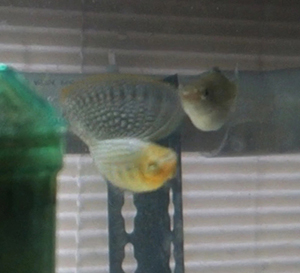
Everyone would like to keep the
Poeclia velifera, the
Giant Sailfin Molly, particularly
the well known population from the Yucatan Peninsula.
It is the iconic Livebearer,
the symbol of the American Livebearer Association, with
a huge fan dorsal covered
with fine, bright and crisp blue, red and orange
markings over its body. It is not
easy to find in the hobby, and for those able to obtain
it, they soon find out that this
is no pet shop molly.
Nothing else looks like this fish, and a large male
doing his high energy display for
a female, opening up that huge dorsal, where the first
dorsal spine comes all of the
way forward so that is points straight ahead, will take
your breath away. They are
are also fairly prolific, so that when
you get their care dialed in, they generally do
very well. They are also well
behaved, non aggressive to one another and other
species, and generally do not eat their
fry.
Also see the basic Care guide for this fish
HERE.
display after being fed and following water
changes. Some males display more than
others, this guy will show off 4-5 times a
day.
Large bull males will sometimes reach 5.5 inches, and
it is not necessary to grow these out in outdoor ponds or large
tanks for them to develop
their sail dorsal, as was once believed. A few can be kept fairly
comfortably in a 40 gallon tank,
most are kept in 55s here.
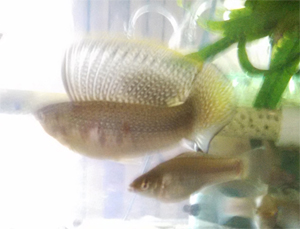
Although the pic at
left is of poor quality, This is the biggest male I have had here
so far, and is
about 5 inches in this picture, well on his way to being a 5.5 - 6 inch
fish. Shortly
after this pic was taken, this male developed a large tumor on his side
and had to be culled. Today I have a number of late
maturing males growing out,
and hope to have
others at least this large in the future!
Nor do they require salt in their water. This line
has never been kept with salt, and does fine without it. However,
particularly when I have
acclimated them here, I will use salt to ease their transition when
coming from another
set of water qualities.
They respond to salt well, and it does come in handy whenever they may
not look their best.
A quick
medicinal dose
will always perk them up. (1 tablespoon per every 5 gallons of water).
Continued
selective
breeding by breeder friends has kept this line large, with frequent,
spectacularly colored,
large males being
produced.
However, this fish has a
number of requirements that must be provided for them to do well. I will
carefully explain exactly
how we keep them
here so that if you wish to keep them they should be at their best for you.
Their needs come down
to a few specific
physical characteristics that need to be understood, and these issues dictate
the care they require.
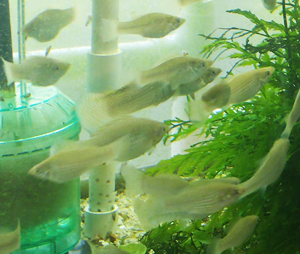
Anyone can keep this fish, but it is not a "beginner
Fish". Their care is not
difficult to provide, but some may decide
this is not the fish for them.
It is currently kept by few fishkeepers, so hopefully
with the information here,
more can keep this
fish successfully and bring them back into the hobby.
I understand that this information is not easy to
find, so I will do my best to
describe their care requirements here.
These are not a difficult fish to keep properly, you simply
have to set out to create a
tank that meets their needs. Nor are they fragile in
any way - when kept correctly
they are an active, hardy, prolific fish. The issue, as
I will address, involves
appropriate filtration, and their need to be fed
more than once per day.
Like any fish with special needs,
until you get their care dialed in, these should be kept in
species only
tanks, where except
for
a pleco or catfish, this large and prolific fish should have the tank to
themselves.
Before I go further, some
customers have asked about putting these into a standard, reasonably
well kept community tank,
and how well will they
do? Assuming we are talking about a moderate stocking level with 1x-2x
feedings per day of a quality
vegetable based dry food,
with good filtration and aeration, and a pH of about 8.0, they should do
OK for a while, and may
even reach adulthood when
kept in reasonably clean conditions. But if you want the glory these
fish are capable of,
it is best to start off giving them the
conditions they require to do their best. Today, these have become a
rare fish in the
hobby, yet are possibly
he most spectacular fish you can keep. Learn to
keep them so they do well, and here will always
be
hobbyists looking for them!
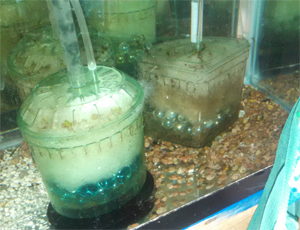
Their tanks are set up as described throughout
this site,
bare bottom with a thin
layer of pea gravel over a minimum of 1/3 - 1/2 of the
tank bottom. However, they
do need to be at a pH of about 8.0, so instead of pea
gravel here, about 1/2 of
the tank bottom is covered with crushed oyster shell to
bring up the hardness
and pH (My pH is about 7.4). They are also a slightly
warmer water fish, and do
best here at 77-80 degrees, though some keep these
routinely as warm as 82-83
degrees. To keep oxygen and filtration as high as
possible, I do not go higher
than 78/79 degrees. (Cooler water holds more oxygen)
The problem with this fish, the reason it is not more
widely kept, is that it has
two aspects to its care required for its survival, and
they conflict with one another.
Before you get this fish, you must provide a setup that
solves this problem, and
getting on top of it will guarantee that they will do
well for you.
of filtration as they are very effective at
removing debris and mulm. How dirty
they are can be seen immediately.
Here is the issue:
This fish is a "grazer",
eating fairly constantly in the wild. While preferring a vegetable heavy
diet, they possess a
relatively short
digestive tract. Normally, an animal with a vegetarian diet has a longer
digestive system as plant material
is more difficult to
process and takes longer to digest. With a short digestive tract, they
then digest what they take in
inefficiently,
releasing more waste than most fish we keep. Because of this, they must
be fed smaller amounts
throughout the day. With
a schedule where you must be gone during the day, they will survive with
a feeding in the AM, and
then 2 more times before
nightfall. Ideally, the tank should be located where they can be fed a
small amount each time
someone walks past. Here,
they are fed 5-6xs per day. And with each feeding they act as if they
are starving, yet may be
stuffing themselves with
bodies already well rounded! Because I am in the fishroom
all day, I am
able to feed each time I
walk past the tank, but
obtaining a quality automatic feeder would be a consideration.
The conflicting issue is that they are also somewhat nitrate intolerant,
and their health will decline when water quality is
inconsistent or is
allowed to deteriorate. And of course, with all that feeding, water
quality will deteriorate quickly.
This is not a deal
breaker, appropriate filtration and
water changes will take care of
that, but you need to first set up a
tank of at least 29
gallons with heavy filtration and routine access to at least 2x per week
water changes of at least 30%
each time to maintain
them, depending on the number of fish in the aquarium. The more fish,
the greater the need for
extra filtration. Full
sized adult fish will need to be moved to at least a 40 gallon aquarium.
Here, two breeder groups
are maintained, about 25 of the largest fish are in a 100
gallon tank, and a second group of
10-12 large, but not
the biggest fish, are in another 55 gallon.
Early
maturing males are culled. The tanks are filtered
with 3 and 4
box filters, and each tank also has a 250 HOT Magnum HOB
filter with the micro cartridge to keep water
quality up. An
automatic water change system changes the water
15% per day. You should be able to maintain them with
weekly 50-75%
water changes. If
stocking levels get high,
occasionally doing a 20-30% change whenever the water
appears the least
bit cloudy is
advised. You must provide filtration that removes the majority of
waste from the water.
Because they are
nitrate intolerant, a sponge filter that is cleaned regularly (weekly)
can be used in conjunction
with box or HOB filters,
but are never to be used as the sole source of filtration (as any any sponge based
filter leaves
the
mulm and decaying matter in the tank).
Obviously, you will not need the canister Hang On Back filter with a few
smaller fish in a 40 gallon aquarium, but you will
need that extra
filtration as they each reach 3.5 inches plus. Through observation you
can come to understand what they look
like at their healthiest,
and add filtration or make changes to the water quality as necessary.
The
box filters provide
robust aeration, and the velifera do not seem to bother the live
Java
and Bolbitis ferns provided in
the tanks. They do
not eat their fry, which hide in the
plants and are easily caught and
moved to grow out tanks where
they are fed
BBS, and
3-4xs per day feedings of a fortified vegetable flake.
Though fed a vegetable
based dry flake throughout the day, they must also be fed one feeding a
day of a higher protein food.
Here we feed a
carnivorous flake, or frozen bloodworms, white worms or chopped
earthworms. Frozen Brine shrimp is also
excellent for them.
This is group of fry being grown out in a
homemade net type breeder. They
need to be grown out with frequent feedings to reach
adulthood at maximum
growth. These do not sex out until they are fairly
large - 2-3 inches, and
poor care of fry will lead to undersized fish that
will sex out even later.
Because they are so food oriented, the young are
kept in breeders
until they approach 3/4ths of an inch (4-6 weeks).
These are about to
be released into the 40 gallon tank used to grow out
young fish. When a
group of 6 fish are purchased, they will be between
this size and
about 1.25 inches.
Raising the fry is not entirely what you
would expect. Fortunately, when well fed they generally do not bother
their fry,
born only slightly larger
than a swordtail or guppy fry. It is best to put them into a net breeder,
and for the first month or
so of growth, there are
no real signs that they will grow into the large 4-5 inch fish we are
hoping for. The growth is
fairly slow, and they are
only about the size of a swordtail or platy fry until about 5-6 weeks.
At this point, with frequent
frequent feedings and
good water quality, their growth begins to take off.
These sex out differently than the
swordtails or mollies. There is very little to
indicate who is going to be a male or a
female until they have reached a good
1.5-2 inches. Some late maturing males (which
are the ones you want to use as
breeders, as they will be the biggest fish)
may not show secondary sexual
characteristics until they are even larger. The top
fish in this photo is just
starting to show the thickening of the gonopodium, and
the dorsal has just begun
to show development of the fine markings that define
the big sailfin dorsal.
These will also produce broods that are female heavy.
The ratio still provides
frequent males, but the ratio here has been
roughly 4-1 females to males in
the conditions (temp and pH) they are kept here.
At about 3/4 inch I move the
fry into a 40 breeder
tank, where their growth is encouraged, after they are old enough
to be feeding confidently
and swimming throughout the tank. All look, at this point, like smaller
females. It will take
a good 5-6
months before you will start to see firm signs of males beginning to sex
out. The problem is that those
sexing out first
are generally the "early maturing males" that will sex out at a very
small size, and you want to
separate those, so they do
not breed with your stock, or the line will diminish in size.
Eventually, the big bull males
will begin to sex out,
and those are the fish you want to use as breeders. Keep in mind when
raising these fry, if
possible, to feed small
amounts of food throughout the day. Here they get
BBS once a day, and
numerous
smaller feedings of a
spirulina based flake.
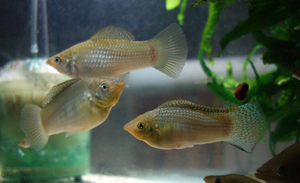
the young male on the left. Already the less mature male is larger than the fish
that is that has sexed out further. The more developed fish already has a
dorsal that has gotten too large to carry erect unless he is trying to draw
attention to himself. The neon blue color is beginning to come out, and you can see
the black outlining starting on the tail. These males are likely the same age, but
the larger fish is later maturing. The more developed fish is still a nice male.
I do not consider this to be an early maturing fish, I have seen fish develop
gonopodiums here at just 1-1.5 inches, and those are culled. This developing male
currently is about 2.5-3 inches, and will likely top out at about 3.5 - 4 inches.
The larger, later maturing fish may eventually reach 5 inches. The top fish
appears to be a clear female.
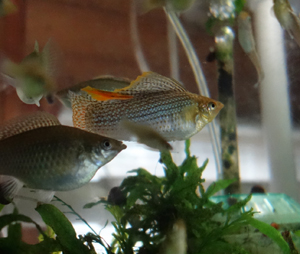
This male has his adult color, and is about 4.5
inches long. You can see the
incredible color that this fish possesses. Under a pen
flashlight the spangles are
a bright green/blue, and this line produces many males
with a canary yellow
undercast. When any of these males are
in full display it really takes your breath
away! This male
will often display after being fed, and after water changes.
Until the males begin to develop color and that
big sailfin, they are fairly indistinct, chunky silverish-white fish.
Overall,
it will take a male about
8-12 months to become full sized, and it will take 5-6 months before
they can be sexed. Once
secondary sexual
characteristics start to develop, the males will grow quickly, with the
sailfin growing daily. At this
point the sexes should be
separated, so that your largest fish of those growing out are bred
toward the next generation.
For the experienced
fishkeeper looking for a modest challenge with a big payoff, and a show
tank that people will not
be able to look away from,
this may be the fish for you! Though water quality can be tricky to get
dialed in, once that is
established, they are a
very well behaved, peaceful and large colorful fish that do not eat their
fry.
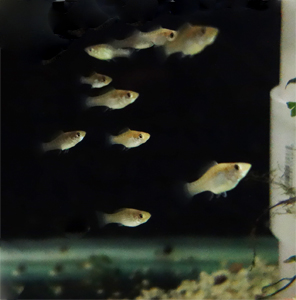
The best way to obtain these is as younger fish, in a
2-4 month old group that are
about 3/4 - 1 inch in size, as they will be least
expensive to ship and will survive
shipping with the fewest losses. Have a 30 or 40
gallon, lightly planted tank with live
plants (so you can keep an eye on them, and to help
maintain water quality) set
up following the guidelines above - pH 8.0, 78 degrees,
single layer of gravel over
1/2 of tank bottom, generous
filtration and
oxygenation, species only, moderate
lighting,
frequent feeding, and the ability to do quick, spot
water changes when necessary, with
routine weekly or twice weekly water changes of at
least 50% weekly.
Here there are two tanks of adult fish, a
55 and a 100. The 55 has approximately 5 males, two that are full
adults, and 8-9 females. The dominant male will flare 4-5 times a day
with casual observation, primarily after
feedings and water changes (and that is when I am most often there to
observe them). As the males mature,
and are in the same tank together with females, the amount of flaring is
frequent enough that it can be seen
a few times per day.
The 100 gallon has a big bull male of about 5 inches with about 15
larger females. He rarely flares, and in fact
I have only seem him flare on a couple occasions. Yet, that tank
produces many fry consistently. My thinking is
that the flaring is for both the females and competing males, and having
both together in the same tank will
increase the amount of flaring going on.
They can also be encouraged to flare by separating the males from the
females for a short period (a day or two),
and reintroduce them followed by a water change and/or feeding.
Currently breeder groups are producing fry that are
sold at 2-3 months. Over time, sexed young adults will be
offered as they become
available. Availability of fry groups and sexed adults will be posted at
the homepage.
If you have any further
questions or concerns, or want to make a comment on anything I have
written at this
site, I would like to
hear from you- just email me at
selectaquatics@gmail.com . Thank you!